1995 CADILLAC ELDORADO mirror
[x] Cancel search: mirrorPage 171 of 395
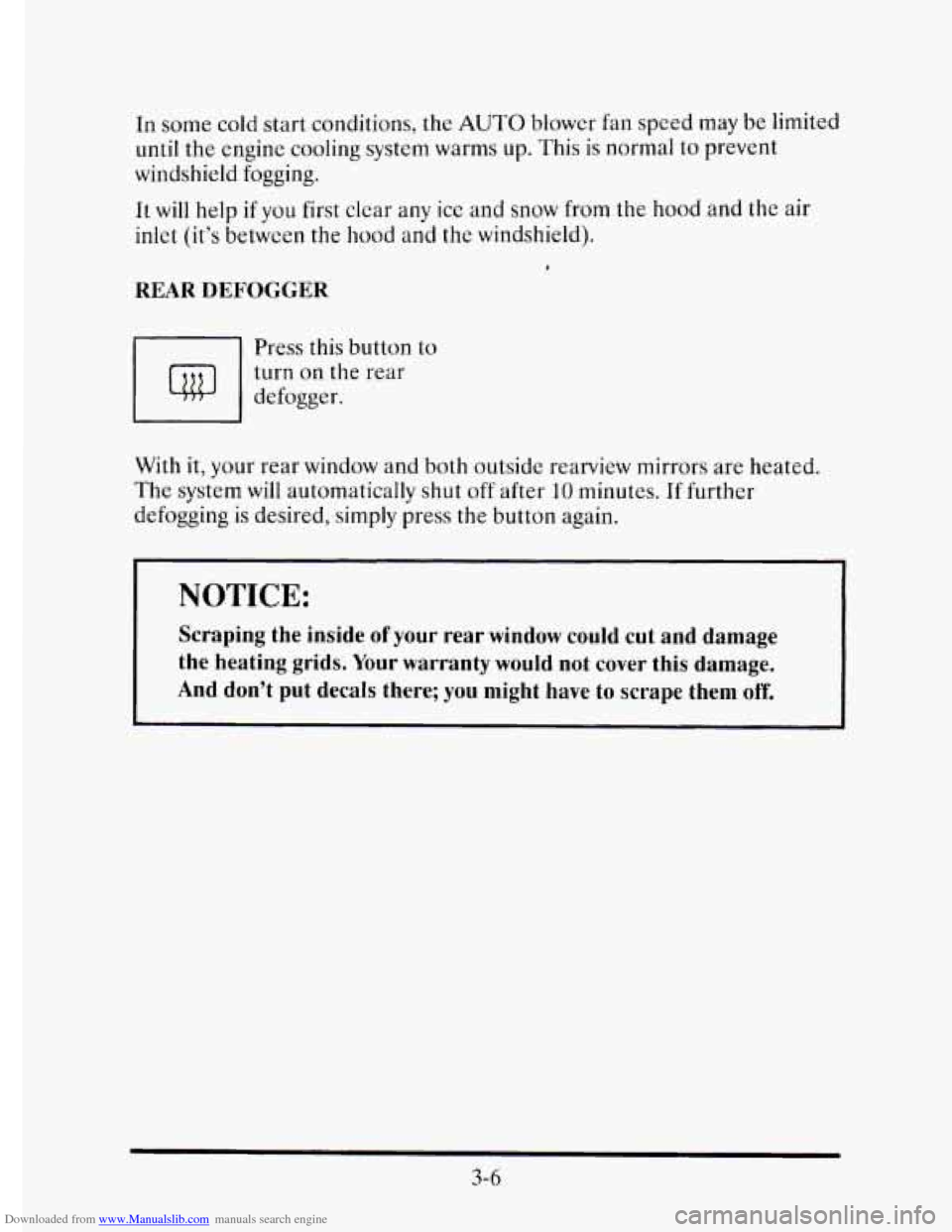
Downloaded from www.Manualslib.com manuals search engine In some cold start conditions, the AUTO blower fan speed may be limited
until the engine cooling system warms up. This is normal to prevent
windshield fogging.
It will help if you first clear any ice and snow from the hood and the air
inlet (it’s between the hood and the windshield).
REAR DEFOGGER
-1 Press this button to
turn on the rear
defogger.
With it, your rear window and both outside rearview mirrors are heated.
The system will automatically shut off after 10 minutes. If further
defogging is desired, simply press the button again.
NOTICE:
Scraping the inside of your rear window could cut and damage
the heating grids. Your warranty would not cover this damage.
And don’t put decals there; you might have
to scrape them off.
3-6
Page 200 of 395
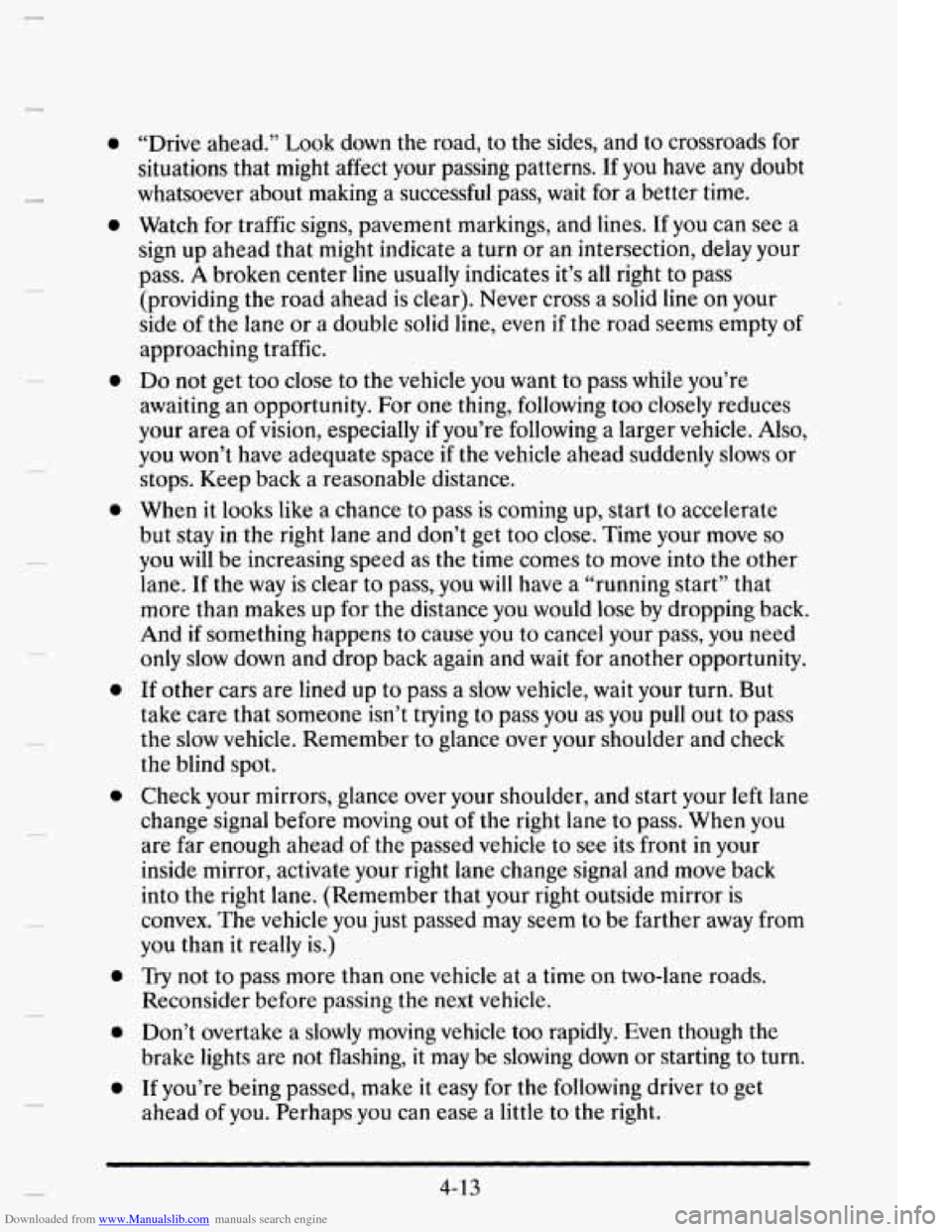
Downloaded from www.Manualslib.com manuals search engine 0
0
c
0
0
0
0
0 0
0
“Drive ahead.” Look down the road, to the sides, and to crossroads for
situations that might affect your passing patterns.
If you have any doubt
whatsoever about making a successful pass, wait for a better time.
Watch for traffic signs, pavement markings, and lines. If you can see a
sign up ahead that might indicate a turn or an intersection, delay your
pass.
A broken center line usually indicates it’s all right to pass
(providing the road ahead is clear). Never cross a solid line
on your
side of the lane or a double solid line, even
if the road seems empty of
approaching traffic.
Do not get too close to the vehicle
you want to pass while you’re
awaiting an opportunity.
For one thing, following too closely reduces
your area of vision, especially
if you’re following a larger vehicle. Also,
you won’t have adequate space if the vehicle ahead suddenly slows or
stops. Keep back a reasonable distance.
When it looks like a chance to pass
is coming up, start to accelerate
but stay in the right lane and don’t get too close. Time your move
so
you will be increasing speed as the time comes to move into the other
lane.
If the way is clear to pass, you will have a “running start” that
more than makes up for the distance you would lose
by dropping back.
And
if something happens to cause you to cancel your pass, you need
only slow down and drop back again and wait for another opportunity.
If other cars are lined up to pass a slow vehicle, wait your turn. But
take care that someone isn’t trying to pass
you as you pull out to pass
the
slow vehicle. Remember to glance over your shoulder and check
the blind spot.
Check your mirrors, glance over your shoulder, and start your left lane
change signal before moving out
of the right lane to pass. When you
are far enough ahead
of the passed vehicle to see its front in your
inside mirror, activate your right lane change signal and move back
into the right lane. (Remember that your right outside mirror is
convex. The vehicle
you just passed may seem to be farther away from
you than it really is.)
Try not to pass more than one vehicle at a time on two-lane roads.
Reconsider before passing the next vehicle.
Don’t overtake a slowly moving vehicle too rapidly. Even though the
brake lights are not flashing, it may be slowing down or starting to turn.
If you’re being passed, make it easy for the following driver to get
ahead
of you. Perhaps you can ease a little to the right.
4-13
Page 201 of 395
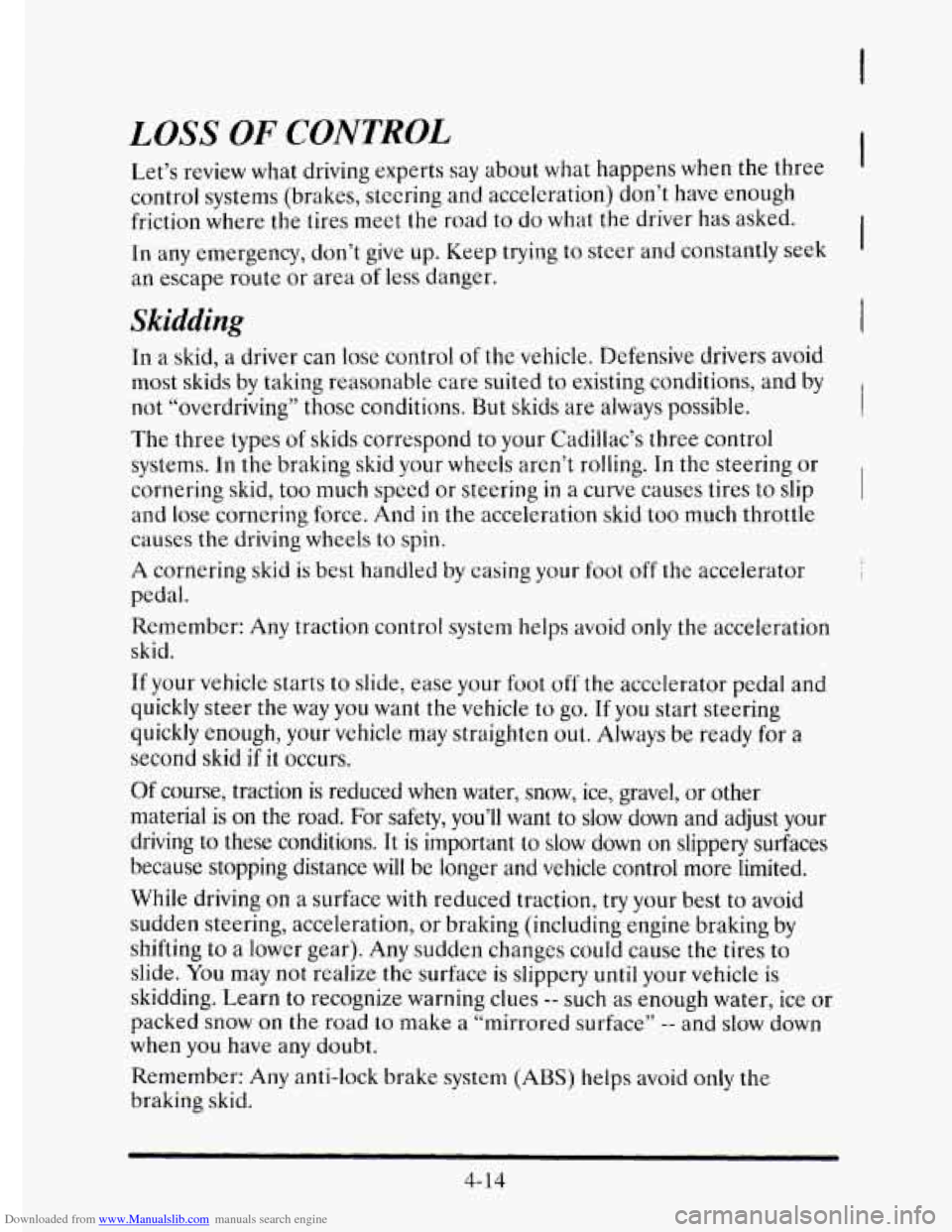
Downloaded from www.Manualslib.com manuals search engine LOSS OF CONTROL
Let’s review what driving experts say about what happens when the three
control systems (brakes, steering and acceleration) don’t have enough
friction where the tires meet
the road to do what the driver has asked.
In any emergency, don’t give up. Keep trying to steer and constantly seek
an escape route or area
of less danger.
Skidding
In a skid, a driver can lose control of the vehicle. Defensive drivers avoid
most skids by taking reasonable care suited to existing conditions, and by
not “overdriving” those conditions. But skids are always possible.
The three types
of skids correspond to your Cadillac’s three control
systems. In the braking skid your wheels aren’t rolling.
In the steering or
cornering skid, too much
speed or steering in a curve causes tires to slip
and
lose cornering force. And in the acceleration skid too much throttle
causes the driving wheels
to spin.
A cornering skid is best handled by casing your foot off the accelerator
pedal.
Remember: Any traction control system helps avoid only the acceleration
skid.
If your vehicle starts
to slide, ease your foot off the accelerator pedal and
quickly steer the way
you want the vehicle to go. If you start steering
quickly
enough, your vehicle may straighten out. Always be ready for a
second skid
if it occurs.
Of course, traction is reduced when water, snow, ice, gravel, or other
material is on
the road. For safety, you’ll want to slow down and adjust your
driving to these conditions.
It is important to slow down on slippery surfaces
because stopping distance
will be longer and vehicle control more limited.
While driving on a surface with reduced traction,
try your best to avoid
sudden steering, acceleration,
or braking (including engine braking by
shifting to a lower gear). Any sudden changes could cause
the tires to
slide. You may not realize the surface is slippery until your vehicle is
skidding. Learn
to recognize warning clues -- such as enough water, ice or
packed snow
on the road to make a “mirrored surface” -- and slow down
when
you have any doubt.
Remember:
Any anti-lock brake system (ABS) helps avoid only the
braking skid.
4- 14
Page 202 of 395
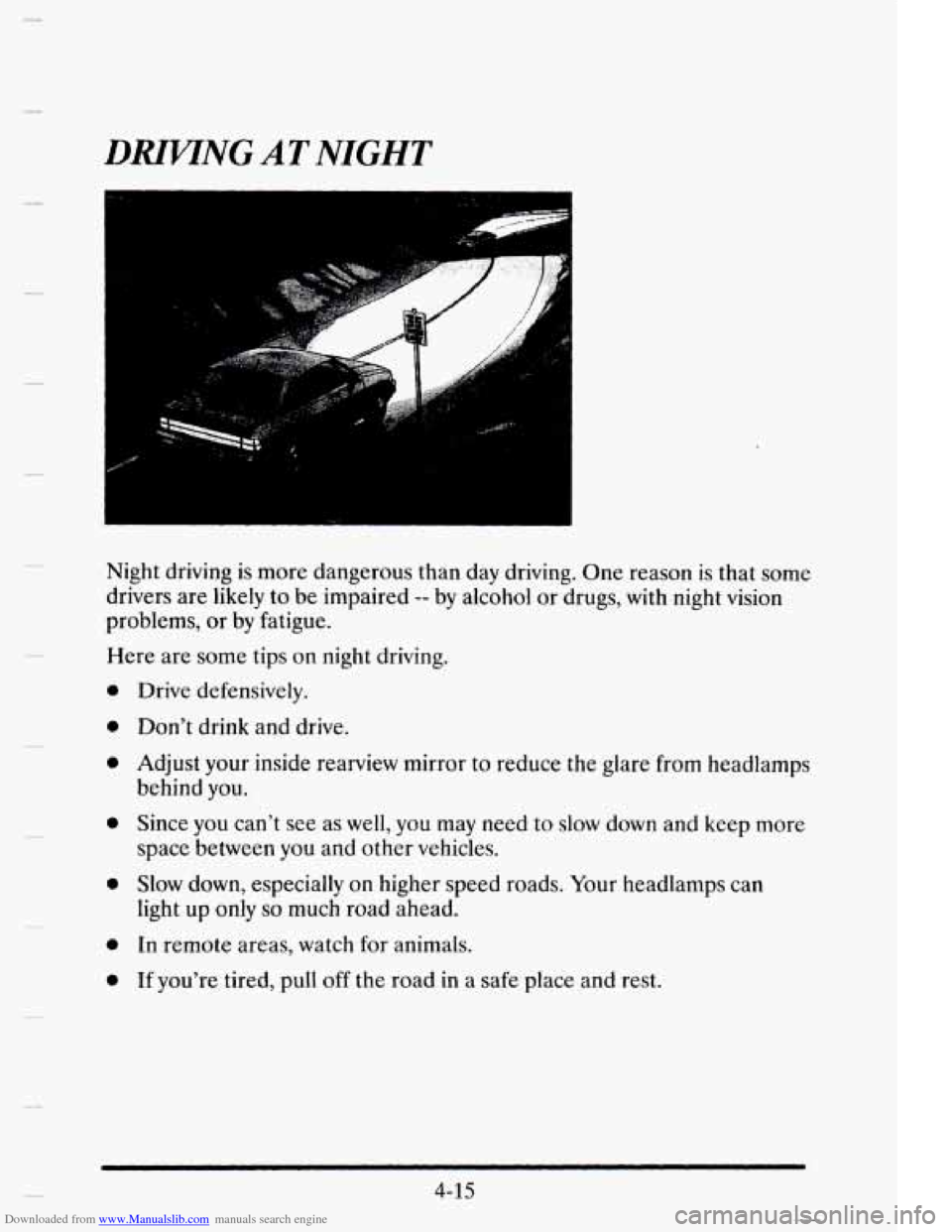
Downloaded from www.Manualslib.com manuals search engine 3RIWNG AT NIGHT
Night driving is more dangerous than day driving. One reason is that Some
drivers are likely to be impaired
-- by alcohol or drugs, with night vision
problems, or by fatigue.
Here are some tips on night driving.
Drive defensively.
Don’t drink and drive.
Adjust
your inside rearview mirror to reduce the glare from headlamps
behind you.
Since you can’t see as well,
you may need to slow down and keep more
space between
you and other vehicles.
Slow down, especially
on higher speed roads. Your headlamps can
light up only
so much road ahead.
In remote areas, watch for animals.
If you’re tired, pull off the road in a safe place and rest.
a
0
0
a
0
0
a
4-15 c-
Page 208 of 395
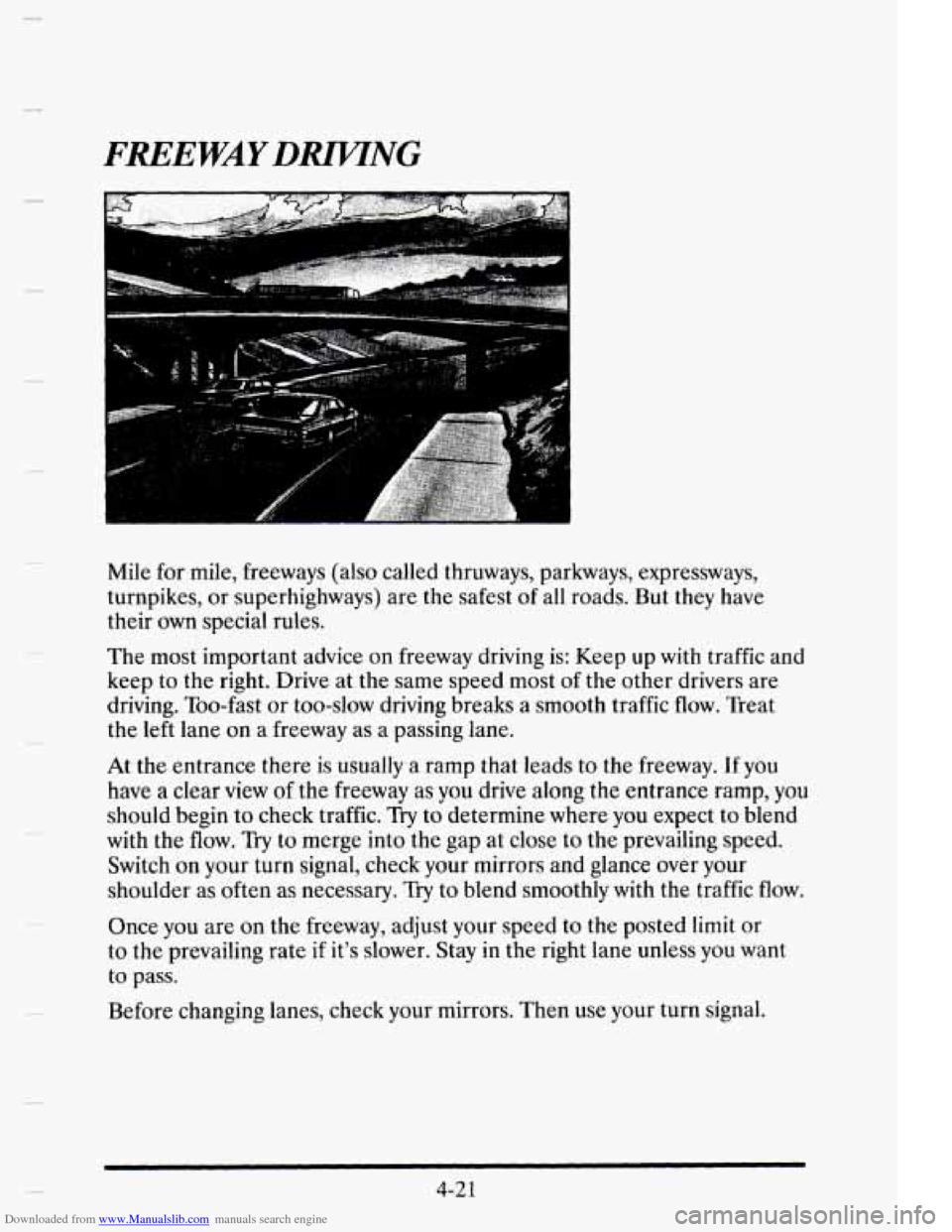
Downloaded from www.Manualslib.com manuals search engine c
Mile for mile, freeways (also called thruways, parkways, expressways,
turnpikes, or superhighways) are the safest
of all roads. But they have
their own special rules.
The most important advice on freeway driving is: Keep up with traffic and
keep to the right. Drive at the same speed most
of the other drivers are
driving. Too-fast
or too-slow driving breaks a smooth traffic flow. Treat
the left lane
on a freeway as a passing lane.
At the entrance there is usually
a ramp that leads to the freeway. If you
have a clear view
of the freeway as you drive along the entrance ramp, you
should begin to check traffic.
Try to determine where you expect to blend
with the
flow. Try to merge into the gap at close to the prevailing speed.
Switch
on your turn signal, check your mirrors and glance over your
shoulder as often as necessary.
Try to blend smoothly with the traffic flow.
Once
you are on the freeway, adjust your speed to the posted limit or
to the prevailing rate if it's slower. Stay in the right lane unless you want
to pass.
Before changing lanes, check your mirrors. Then use your turn signal.
4-21
Page 210 of 395
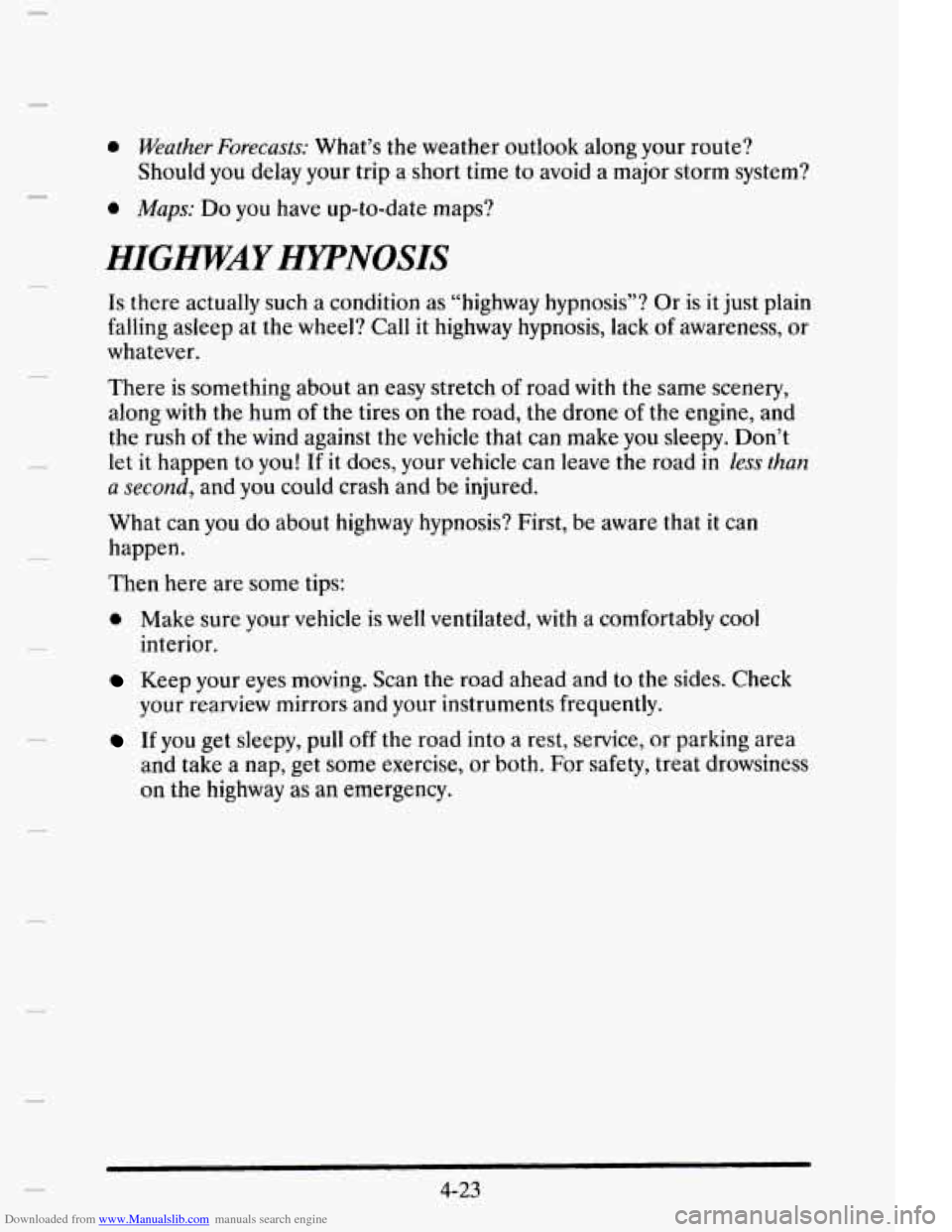
Downloaded from www.Manualslib.com manuals search engine 0 Weather Forecasts: What’s the weather outlook along your route?
0 Maps: Do you have up-to-date maps?
Should you delay your
trip a short time
to avoid a major storm system?
HIGWAY HITNOSIS
Is there actually such a condition as “highway hypnosis”? Or is it just plain
falling asleep at the wheel? Call it highway hypnosis, lack of awareness, or
whatever.
c
There is something about an easy stretch of road with the same scenery,
along with the
hum of the tires on the road, the drone of the engine, and
the rush
of the wind against the vehicle that can make you sleepy. Don’t
let it happen to you! If it does, your vehicle can leave the road in less than
a second, and you could crash and be injured.
What can
you do about highway hypnosis? First, be aware that it can
happen.
Then here are some tips:
0 Make sure your vehicle is well ventilated, with a comfortably cool
interior.
Keep your eyes moving. Scan the road ahead and to the sides. Check
your rearview mirrors
and your instruments frequently.
If you get sleepy, pull off the road into a rest, service, or parking area
and take a nap, get some exercise, or both. For safety, treat drowsiness
on the highway as an emergency.
4-23
Page 224 of 395

Downloaded from www.Manualslib.com manuals search engine Driving with a Trailer
n Towing a trailer requires a certain amount of experience. Before setting
out for the open road, you’ll want to get to
know your rig. Acquaint
yourself with the feel
of handling and braking with the added weight of
the trailer. And always keep in mind that the vehicle you are driving is
now a good deal longer and not nearly as responsive as your vehicle is by
itself.
Before you start, check the trailer hitch and platform (and attachments),
safety chains, electrical connector, lamps, tires and mirror adjustment. If
the trailer has electric brakes, start your vehicle and trailer moving and
then apply the trailer brake controller by hand to be sure the brakes are
working. This lets you check your electrical connection at the same time.
. During your trip, check occasionally to be sure that the load is secure, and
that the lights and any trailer brakes are still working.
Following Distance
Stay at least twice as far behind the vehicle ahead as you would when
driving your vehicle without a trailer. This can help you avoid situations
that require heavy braking and sudden turns.
Passing
You’ll need more passing distance up ahead when you’re towing a trailer.
And, because you’re a good deal longer, you’ll need to
go much farther
beyond the passed vehicle before you can return to your lane.
Backing Up
Hold the bottom of the steering wheel with one hand. Then, to move the
trailer to the left, just move that hand to the left.
To move the trailer to
the right, move your hand to the right. Always back up slowly and,
if
possible, have someone guide you.
4-37
Page 319 of 395
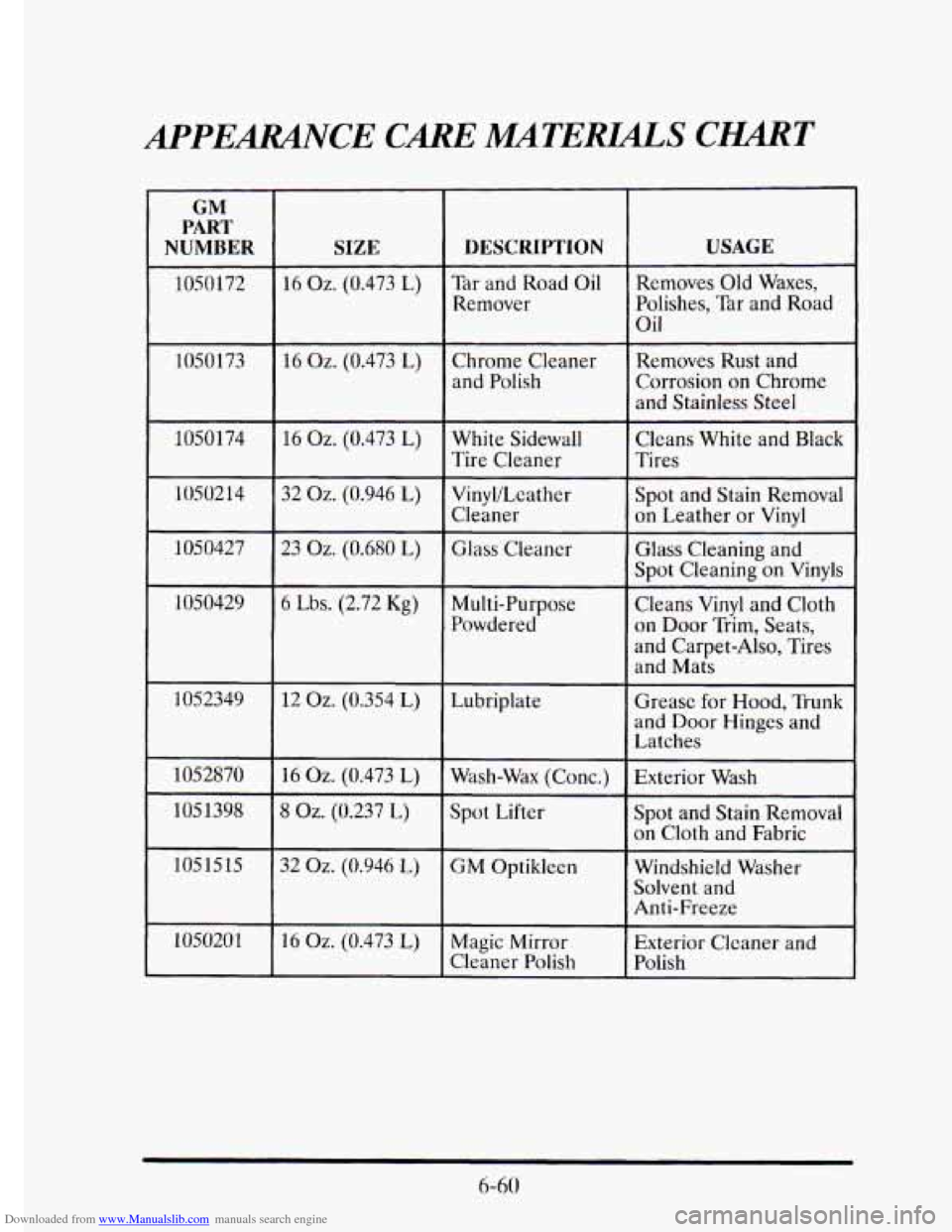
Downloaded from www.Manualslib.com manuals search engine APPEMCE CAREMTERllALS C'T
GM
PART
NUMBER SIZE DESCRIPTION
1050172 16 Oz. (0.473 L) Tar and Road Oil
Remover
1050173
16 02. (0.473 L) Chrome Cleaner
and Polish
1050174
16 02. (0.473 L) White Sidewall
1050214 32
Oz. (0.946 L) Vinyl/Leather Tire Cleaner
Cleaner
I 1050427 I I
23 02. (0.680 L) Glass Cleaner
1050429
6 Lbs. (2.72 Kg) Multi-Purpose
Powdered
I 1051398 I 8 02. (0.237 L) I Spot Lifter
1051515 32
Oz. (0.946 L) GM Optikleen
1050202 16 02. (0.473 L) Magic Mirror
Cleaner Polish
USAGE
Removes Old Waxes,
Polishes, Tar and Road
Oil
Removes Rust and
Corrosion
on Chrome
and Stainless Steel
Cleans White and Black
Tires
Spot and Stain Removal
on Leather or Vinyl
Glass Cleaning and
Spot Cleaning
on Vinyls
Cleans Vinyl and Cloth
on Door Trim, Seats,
and Carpet-Also, Tires
and Mats
~ ~~
Grease for Hood, Trunk
and Door
Hinges and
Latches
Exterior Wash
Spot and Stain Removal
on Cloth and Fabric
WindshieId Washer
Solvent and
Ant i-Freeze
Exterior Cleaner and
Polish
6-60